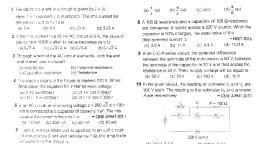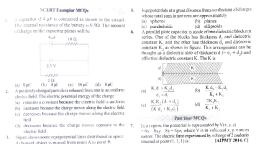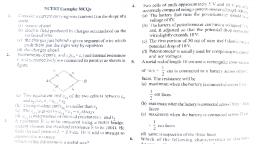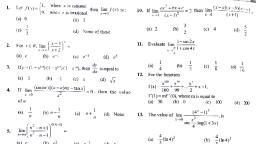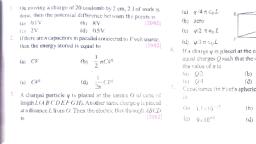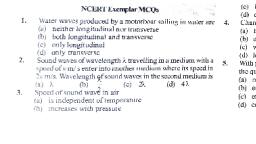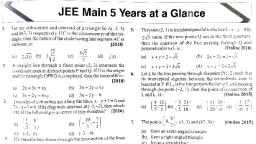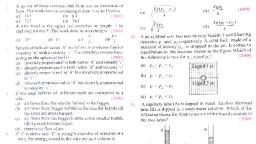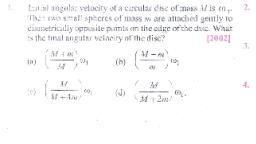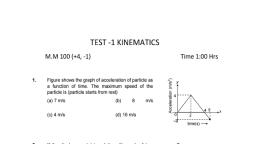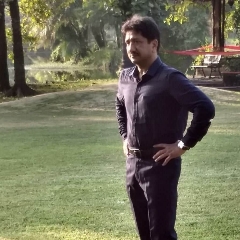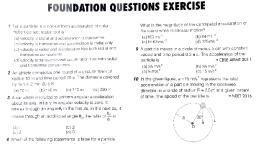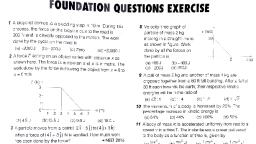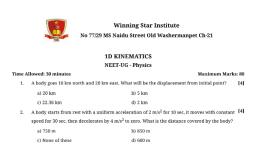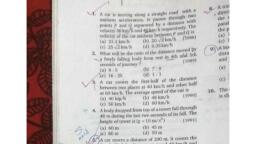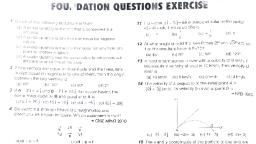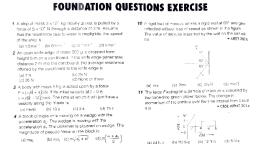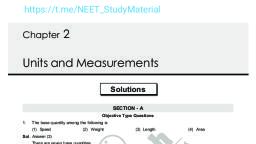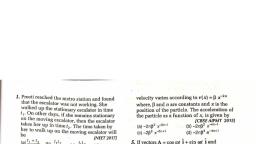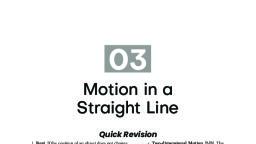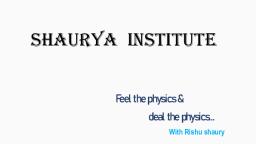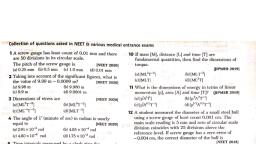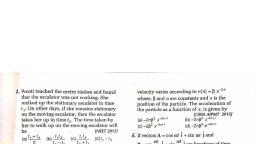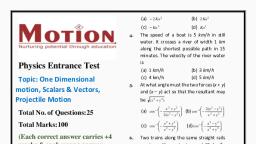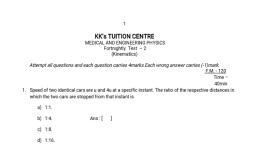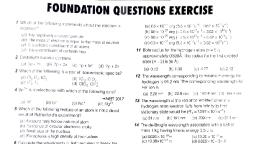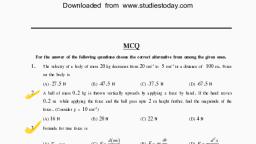Page 1 :
(DAY, , PRACTICE SESSION, , 1), , FOUNDATION QUESTIONS EXERCISE, 1, , Awheel of, , radius 1m rolls forward half, , revolution ona, horizontal ground. The magnitude of the displacement of, the point of the wheel, initially in contact with the ground, a, , instant is 10 ms', After, 8 The velocity of a particle at an, The velocity at 2 s, 3s its velocity will become 16 ms., before the given instant, will be, , (b) 4 ms', , (a) 6 ms, , S, , (a) 2, , (b) 2, , x, , (c) T+4, , (d), , 2 In one dimensional motion, instantaneous speed v, , statisfies 0SvSVo., (a) The displacement x in time Tmust always take, non-negative values, (b) The displacement x in time Tsatisfies -V,T<X<VoT, (c) The acceleration is always a non-negative number, (d) The motion has no turning point, , 3 A particle moving in a straight line covers half the, , distance with speed of 3 m/s. The other half of the, distance is covered in two equal time intervals and with, , speeds of 4.5 m/s, , and, , 7.5 m/s, respectively., , The, , average speed of the particle during this motion is, (c) 5.5 m/s, (d) 4.8 m/s, (b) 5 m/s, (a) 4 m/s, 4 Preeti reached the metro station and found that the, , escalator was not working. She walked up the stationary, escalator in time t. On other days, if she remains, stationary on the moving escalator, then the escalator, takes her up in time t2. The time taken by her to walk up, , on the moving escalator will be, , (a), , (c) 4 2, , (b), , t2+, , NEET 2017, (d)-t2, , straight line traversed one-third, The remaining, of the total distance with a velocity 4 ms., a, with, velocity, 2ms, part of the distance was covered, the other half, for, with, and, 6ms, velocity, time, for half the, , 5 A, , body travelling along, , a, , of time. The average velocity Over the whole time of, , motion is, , (a) 5 ms1, , (b) 4 ms, , (c) 4.5 ms, , (d) 3.5 ms, , 6 A body is moving with velocity 30 m/s towards East. After, 10 s its velocity becomes 40 m/s towards North. The, average acceleration of body is, , (a) 7 m/s2, , (b) 7 m/s2, , (c)5 m/s, , (d) 1 m/s2, , 7 A body initially at rest is moving with uniform acceleration, a m/s. Its velocity after n second is v. The displacement, , of the body in last 2sis, , (a), , n-1), , (c) n +, , 9 An object moves, starting from rest through, , (b)-, , (d) 2, , (2n+ 1), n, , a, , resistive, , medium such that its acceleration is related to velocity, , as, a = 3 -2v. Then,, , (a) the terminal velocity is 1.5 unit, (b) the terminal velocity is 3 unit, (c) the slope of a-v graph is not constant, (d) initial acceleration is 2 unit, 10 A particle moves in a straight line with a constant, to, from 10 ms, acceleration. It changes its velocity, m in, 135, distance, a, 20 ms, while passing through, is, t second. The value of t (in second), )9, (a) 12, (d) 1.8, , (c) 10, , uniform, 11 A particle moving in a straight line with, a from a fixed, distance, be, a, to, acceleration is observed, same point, the, from, d, distance, b, c,, point initially. It is at, the, of, acceleration, particle is, The, seconds., after n, 2n, 3n, (a) C 2 b, , +, , ( b )C * b + a, , a, , 92, , n, (c), , C+ 26+, , (d), , a, , b+a, n, , 4n, , 10 s, 12 A car accelerates from rest at constant rate for first, next, and covers a distance x. It covers a distance y in, 10 s at the same acceleration. Which of the following is, , true?, , (a) x, , =, , 3y, , (6)y=, , 3x, , (c)X= y, , (d) y = 2x, , 13 A car starts from rest, moves with an acceleration a and, then decelerates at a constant rate b for sometime to, maximum, come to rest. If the total time taken is t. The, , velocity of car is given by, , abt, (a)7(a+, b), , (b)at, , a+ b), (d) bt, a+b), , at, , (Ca+b), , 14 A particle starts its motion from rest such that its velocity, remains constant. If the distance covered in first 10 s is, , S, , and that covered in the first 20, (a) s, , n, , (d) 1 ms, , (c) 2 ms1, , = 2s, , (b) s2 = 3s, , s, , (c) s, , is s2, then, = 4s, , (d) s, , S, , 15 A bullet loses 1/20 of its velocity after penetrating a, plank. How many planks are required to stop the bullet?, (a) 6, , (b) 9, , (c) 11, , (d) 13
Page 2 :
16 A man throws balls with, the same speed vertically, upwards one after the other at an interval of 2 s. What, should be the speed of the, throw, so that more than two, balls are in the sky at, time?, any, (Given, g 9.8 ms), =, , (C), , non-uniform accelerated, , (d) Nothing, , can, , motion, be said about the, , under, , gravity., , D, from rest at t, (a) The particle was released, (b) At B, the acceleration a >0, acceleration, (c) At C, the velocity and the, , 3, , (d) h= ha =ha, , 18 A boy standing at top of, stone., , ASsuming, , g, , incorrect, , It covers distances, , h.h2 and hg in the first 5 s, the next 5 s and the next 5 s,, respectively. The relation between h1.h2 and ha is, (b)h= =s NEET 2013, (a) h=2h2 =3hs, (c)h 3h, and hs =3h2, , Choose, , BC, , (C)Greater than 19.6 ms', (d)At least 9.8 ms, , freely, , figure., , in, 24 A graph of x versus t is shown, statements from below., , (a)Any speed less than 19.6 ms, (b)Only with speed 19.6 ms, , 17 A stone falls, , motion, , tower of 20 m height drops a, =10 ms,the velocity with which it, a, , hits the ground is, , CBSE AIPMT 2011, , (d), , The, , speed, , at, , D exceeds than, , =, , O, , atE, , as given in this, particle shows distance-time curve, of the, instarntaneous, velocity, figure. The maximum, , 25 A, , (a) 20 m/s, (b) 40 m/s, (c) 5 m/s, (d) 10 m/s, 19 A ball is dropped from a high rise platform at t 0, starting from rest. After 6 s another ball is thrown, downwards from the same platform with speed v. The, two balls meet at t =18s. What is the value of v?, , particle is around the point, , =, , D, , C, B, , CBSE AIPMT 2010, (a) 74 ms-, , (b) 55 ms, , (c) 40 ms, , (d) 60 ms-1, , 20 A, , body, , is thrown, , vertically, , up with, , a, , Time, , velocity, , u., , It, , passes, , three points A, B and Cin its upward journey with, , velocity, , (c) D, , 26 The position-time graph for a uniform motion is, represented as, , andrespectively. The ratio of separations, , between points AB and between BC, i.e. A is, (a) 1, , (c), , (b) 2, , (b) C, (d) A, , (a))B, , 10, , (b), , (a), , >t, , (), , 21 When a ball is thrown up vertically with velocity Vo. t, , reaches a maximum height of h. f one wishes to triple the, , (c), , (d), , maximum height, then the ball should be thrown with, , velocity, (a) 3 Vo, , t, , (c) 9 Vo, , (b) 3 Vo, , (d) 3/2 Vo, , 22 From the top of a tower two stones, whose masses are in, , the ratio 1:2 are thrown on straight up with an initial, , speed u and the second straight down with the, speed u. Then, neglecting air resistance, , 27, , Among the four graphs, there, , is, , same, , (a) the heavier stone hits the ground with a higher speed, (b) the lighter stone hits the ground with a higher speed, both the stones will have the same speed when they hit, , (a), , (b), , (c), , the ground, , (d) the speed, , can, , not be determined with the, , 23 The velocity-time graph of particle, is, non-linear curve. The motion, motion, , (a) uniform velocity, accelerated, (b) uniformly, , motion, , comes, , given data, , out to be, , a, , only, , one, , graph, , for which, , average velocity over the time interval (0,T) can vanish for, suitably chosen T. Which one is it?, , (c), , (d)
Page 3 :
28 A, , toy car with charge q moves on a frictionless horizontal, plane surface under the influence of a uniform electric, field E.Due to the force qE, its velocity increases fromm0, , 32 A particle of unit mass undergoes one-dimensional, motion such that its velocity varies according to, , vx)=Bx 2, , to 6 m/s in are second duration. At that instant, the, , direction of the field is reversed. The car continues to, move for two more second under the influence of this, field. The average velocity and the average speed of the, toy car between 0 to 3 seconds are respectively., NEET 2018, (a) 1 m/s, 3.5 m/s, , (b) 1 m/s, 3 m/s, , (c)2 m/s, 4 m/s, , (d) 1.5 m/s, 3 m/s, , 29 A particle moving along X-axis has acceleration f, at time, , tgiven byf=%|1-5].where fo, , and, , Tare constants., , The particle at t =0 has zero velocity. In the time interval, between i 0 and the instant when f 0, the particle's., velocity (v^) is, =, , (a) 6T, , =, , (b)67, , (c)6T, , in second. What will be the position of this particle when, it achieves maximum speed along the +X direction?, , 31 An, , (b) 54 mn, , object moving, , with, , a, , (c) 81 m, , speed of, , 6.25, , (d) 24 m, , m/s, is, , dv, , given by dt =-2.5 v, where vis, speed. The time taken by the object, to, , deaccelerated at a rate, , the instantaneous, Come to rest would be, , (a) 2s, , (b) 4 s, , (a) -2nß2x-2n 1, , (d) 1s, , (b)-2n82x4-1, , (d)-2nB2e4n1, , (c)-28x2n+1, , 33 A particle moves a distance x in time t according to, , equationx, , =(t + 5). The acceleration of particle is, , CBSE AIPMT 2010, , proportional to, , (b) (distance), , (a)(velocity), , (d) (velocity) 2/3, , (c)(distance)-2, , At + Bt, where A and B, 34 If the velocity of a particle is v, are constants, then the distance travelled by it between, NEET 2016, 1s and 2s is, =, , (b)AB, , (a) 3A+7B, , (c)A4B, , (, , 35 Two cars P and Q start from a point at the same time in a, straight line an their positions are represented by, Xp(t) at + bté and X(t) ft-t6. At what time do the, NEET 2016, cars have the same velocity?, =, , =, , (b)+ f, , (a)-f, 1+b, (c)+ f, , 2(1+b), (c) 8 s, , CBSE AIPMT 2015, , x, is given by, , (a)67, , 30 The position x of a particle with respect to time t along, X-axis is given by x = 9t - t ,where x is in metre andt, , (a) 32 m, , where, B and n are constants and x is the position of the, particle. The acceleration of the particle as a function of, , 2(b-1), , (d)-, , f-a, , 2(1+ b)

